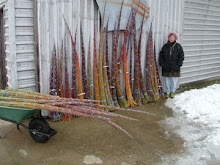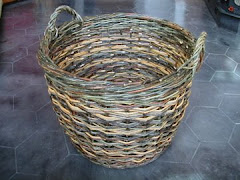
Monday, April 27, 2009
York Spring School Week
A week in the walled city of York in April, what could be better? The daffodils were out and the BA’s York Spring School was in full swing. Classes were at The Mount School and this year featured willow with Roy Youdale, skeined willow with Andris Lapins, twills with Linda Mowatt, split chestnut with Lluis Grau and ropework with Des Pawson.
Roy Youdale’s class was on round square baskets and D-shaped baskets and lids. As space was limited in my suitcase, I concentrated on the round square and was rewarded with a full week’s instruction on the finer points of willow basketmaking. We worked with buff willow which takes very little soaking, time is of the essence in a week long class. The tannin in the willow bark is driven into the rod by boiling and the lovely brown colour is exposed when the bark is peeled off.
The 8 students produced quite a few baskets.
We were privileged to visit Andris Lapins’ class in session and were given a demonstration on skeining willow.
This was Andris’ sample table. The quality of his work is breathtaking, see the earrings in the little bowl?
Linda Mowatt’s twill class produced a feast of pattern and colour.
Des Pawson’s students were busy on the ropes all week, too much for one photo.
After the weeks’ classes, we took a day to explore York. Particularly interesting were the archaelogical displays at the recreation of the ancient Viking city of Jorvik, found underground at Coppergate. When in York, everyone walks the wall and we entered by climbing the steps in this picturesque tower.
Studying at the York Spring School is like going away to camp, you can sleep in a dorm, new friends are made and you feel lost after it’s over. I felt I wanted to take all the classes but there’s always another year and plans are already being made to attend the 2011 Spring School at York.
Wednesday, April 22, 2009
Hunting the Giant Willow
So we took a couple of days to hunt down some of these amazing creations and found the Boizenburger Schneck (Snail of Boizenburg) not too far from Hamburg. The weidenschneck (willow snail) was down by the Elbe River and when we saw all the high waters we wondered if it could be marooned out there, inaccessible. We drove back and forth along the river, searching, searching. We then resorted to asking for directions and hit pay dirt!

Through driving rain we walked down from the town and then found we could have driven up to it! Back to the car and we finally arrived at our goal. The snail was raised in 2005. No leaves yet this year, it’s still winter here but can you imagine walking through when it’s all green and leafy and climbing to the upper deck in the tower? Or watching performances on the stage? What a fabulous idea for any community!

There is a weidensymphonie (willow orchestra) on the same site. See the diagram of instruments here.

Each instrument is represented by a willow sculpture. Here is the piano and beyond is the bass then perhaps a trumpet on the left and a horn on the right, and is that a saxophone too? The tall straight ones are flutes, this was fascinating.

The entire orchestra must be represented here because the walk is at least 300 metres long. The long drive and the search were well worth it.
Another day, another search. Snowing this time, we drove to Wendeburg, about an hour from Hannover to find the weidenkirche (willow church). There it was in a churchyard right in town and obviously is being used for services, at least in the warmer weather - brrrrr! It was a nasty day - can you see the snow falling in this photo? That looks like espaliered trees in the surrounding fence in the background, it must be wonderful in the summer to worship here. There are a number of these willow churches in Germany and Googling 'weidenkirche' will find them for you. Pappenheim, Bayern, Steinberg are some of the towns and there is actually a cathedral at Rostock which was built in two months in early spring 2001 with over 600 volunteers from 12 different countries around the world. We’ll make a trip to Rostock another time, it’s quite a trek - but a willow cathedral! Amazing!

I found this design at Wendeburg simple and regular, it could be adapted for smaller structures. What to do with that heavy willow, yes this would be perfect for a nice shady retreat, large enough for a bench or two.
We had a great day in spite of the weather and when back in Hannover, drove around to find some temporary willow structures in a downtown church square. They were recently put up right on the pavement in beds of soil which are bounded by heavy logs, interesting to see how they will fare in the summertime. Three of these were put up around this church and they must be intended as decorative structures because there are no real openings inviting access to the interior. Hope the barriers will come down once the rods have taken root and leafed out.

The hunt for giant willow was definitely a fun highlight of this visit to Germany! Thanks to a loving and dedicated daughter who chauffeured her willow-obsessed mother on these day trips!
Thursday, April 16, 2009
Colours of the Harvest
I like to do the cutting with my secateurs usually as close as possible to the ground, using a straw cushion that is perfect for kneeling in the wet. Wear lots of clothes and keep working away at it until it’s done. The sound of the rods against each other as you cut is music, a rhythm develops. It’s exciting to see the colours of the different varieties - here are fresh rods of Chermesina, Brittany Green, Sangria, Lancashire Dicks and Dean Yellow. They dry to darker shades but are still beautiful.

Once the willow has been sorted, labelled and bundled, I lay it out on a rack in the darkened spare bedroom for drying. A fan keeps the air moving and it takes 6 weeks or so to dry down enough for storage. So for a couple of months a year, no house guests!



















